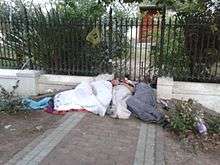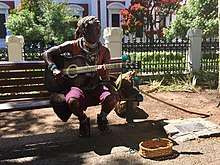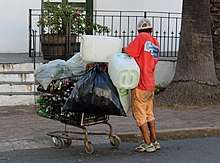Homelessness in South Africa
Homelessness in South Africa dates back to the apartheid period.[1] Increasing unemployment, lack of affordable housing, social disintegration, and social and economic policies have all been identified as contributing factors to the issue.[2] Some scholars argue that solutions to homelessness in South Africa lie more within the private sphere than in the legal and political spheres.[3]

There is no national census on homeless people in South Africa, researchers instead rely on individual studies of homeless persons in particular cities.[4] The South African homeless population has been estimated at approximately 200,000.[5]
One study found that three out of four South African metropolitan municipalities viewed homelessness primarily as a social dependency issue, responding with social interventions. At the same time, homeless South Africans indicated that the most important thing the municipality could assist them with was employment and well-located affordable housing.[6]
History
Early history through the 1800s
In the 19th century the main issues for the colonies was of squatting and vagrancy after much of the land was taken by white people to be farmed. Mid 19th century, under the colonial rule efforts were made to remove non-white people from white owned property, causing the displacement and a large wandering population looking for work.[7]
The introduction of Cape’s Vagrancy and Squatting Act (1878) and other legislation passed by the colonies, were enacted to change the status of vagrants or wanders living on the land into residential labour status to prevent any crime risks associated with the wandering population.[7]
Apartheid period
During the apartheid period, racial segregation and anti-black policies were used to preserve white rule of the country. Zoning laws-controlled movement and place of residence for black people forcing them into black townships in the white ruled cities.[8] Visible homelessness was not allowed on the streets, so those disposed from apartheid policies shifted towards to shack settlements.[7]
Natives Land Act 1913 eventually known as the Black Land Act, 1913 legalised the use of racial distinction that denied rural black famers access to land.[9] Formed forced ‘scheduled areas’ that prevented the buying and selling of land to make any profit. It encouraged segregation, controlled movement and spatially segregated residence within urban areas, this was expanded on throughout the apartheid.[10] From this piece of legislation there was a severe increase in policies and legislation of racial segregation, limiting areas for blacks to live, forcing them into townships. The Native Land Act was the first piece of legislation to enforce territorial segregation and was the beginning of racial segregation in institutionalising it into South African legislation.[11]

In 1927 the first township called Langa was founded in Cape Town. Later in the 1950’s townships of Nyanga and Guglethu were developed and increased in size.[12]
Severe housing shortages in 1968 lead to high overcrowding and the construction of informal illegal settlements widespread throughout the cities.[12]
Causes
Homelessness is shaped by social and economic insecurity which is worsened by informal housing and lack of legislation by the government.[13] Financial pressure put on those living on the street is worsened as they have no ability to accumulate wealth, unlike the shack population.[7]
Even with improving economy unemployment is still at 27%, contributing to homelessness.[14] [15]

High rates of migration into urban areas whereby the government is unable to cope with the influx.[16] Post-apartheid, free movement of non-white South Africans into areas that were restricted to them, resulting in not enough employment opportunities available.[17]
Prevalence
Demographics
There is a lack of consensus on the total amount of homeless people living on the street. The Human Science Research Council (HSRC) state that there is an estimate between 100,000 and 200,000 nationwide living on the streets.[18]
On the streets are typically street children or single adults not whole families.[19] The street homeless population is predominantly black and male.[19] There is a higher prevalence of men on the street, while in the shack population there is a larger female population. A profile of homeless people in Cape Town found that there were 3 times more males then females living in homeless shelters.[20]
Rural areas have a higher proportion of homeless than in cities whereby a larger percentage of rural population is poorer than metropolitan areas.[21]
Street Children
Large migration of street children across borders into South Africa originally come from other bordering countries such as Zimbabwe, this migration occurrence is an increasing situation facing homeless children.[19]
A high percentage also come from urban townships compared to the higher rate of adults coming from rural areas. They are forced to leave as there is not enough resources to support them in poverty stricken living spaces.[22]
Street Children suffer physical and phycological abuse and often turn towards drug and alcohol abuse.[23]
Advocacy response
‘Surfers not street children’ is an advocacy group based in a city called Durban teach street kids how to surf in order to help them to foster connectedness. Its aim is to help them with psychological issues, caused by difficult childhoods.[24]
Government response
There is no specific governmental policy to protect the homeless. A 2003 report found that there was no direct national housing plan for people who lived on the streets, but policy falls predominantly under the Housing and the Social Welfare sectors.[25] Public spending has gone towards supporting shelters for the homeless, however it is only remedial and not a long-term solution.[22]
In 1994 in a post-apartheid period, the Department of Housing aimed to provide a million houses over the next five years. To help alleviate homelessness, the provision of shelter to transition into more permanent living space was implemented by the department of housing as a result of 1994 White Paper on a New Housing and Policy Strategy for South Africa.[25]
Literature
Child homelessness in South Africa has been portrayed in the novel Thirteen Cents by K. Sello Duiker.[26]
Homelessness in South African cities has been portrayed in art in a controversial piece titled Birds in a Cornfield.[27]
See also
References
- Olufemi, Olusola. "Street homelessness in Johannesburg inner-city: a preliminary survey." Environment and Urbanization 10, no. 2 (1998): 223-234.
- Mji, Gubela. "Disability and homelessness: a personal journey from the margins to the centre and back." a south african agenda (2006): 350.
- Nussbaum, Martha C. "Introduction to comparative constitutionalism." Chi. J. Int'l L. 3 (2002): 429.
- Speak, Suzanne. "Relationship between children's homelessness in developing countries and the failure of women's rights legislation." Housing, Theory and Society 22, no. 3 (2005): 129-146.
- "Homelessness in South Africa".
- Du Toit, Jacques Louis. "Local metropolitan government responses to homelessness in South Africa." Development Southern Africa 27, no. 1 (2010): 111-128.
- Cross, Catherine; Seager, John; Erasmus, Johan; Ward, Cathy; O'Donovan, Michael (2010). "Skeletons at the feast: A review of street homelessness in South Africa and other world regions". Development Southern Africa. 27 (1): 5–20. doi:10.1080/03768350903519291. ISSN 0376-835X.
- Christopher, A. J. (1997-10-01). "Racial land zoning in urban South Africa". Land Use Policy. 14 (4): 311–323. doi:10.1016/S0264-8377(97)00025-2. ISSN 0264-8377.
- Banda, Sibo (2006-01-01). "Land Law Reform: A Comparative Analysis of South Africa'S Labour Tenancy Contract and Malawi'S Tenant Worker'S Contract". Oxford University Commonwealth Law Journal. 6 (2): 201–225. doi:10.1080/14729342.2006.11421472. ISSN 1472-9342.
- Crais, Clifton; McClendon, Thomas V., eds. (2013-11-19). The South Africa Reader: History, Culture, Politics. Duke University Press. doi:10.1215/9780822377450. ISBN 978-0-8223-7745-0.
- Coles, Catherine (1993-08-01). "Land Reform from Post-Apartheid South Africa". Boston College Environmental Affairs Law Review. 20 (4): 699.
- International perspectives on homelessness. Polakow, Valerie., Guillean, Cindy. Westport, Conn.: Greenwood Press. 2001. pp. 262–308. ISBN 0-313-00397-1. OCLC 50816760.CS1 maint: others (link)
- Naidoo, Vinothan (2010). "Government responses to street homelessness in South Africa". Development Southern Africa. 27 (1): 129–141. doi:10.1080/03768350903519408. ISSN 0376-835X.
- "OECD Economic Outlook, Volume 2018 Issue 2". www.oecd-ilibrary.org. pp. 187–189. doi:10.1787/eco_outlook-v2018-2-en. Retrieved 2020-06-02.
- Steen, Adam; Mackenzie, David; McCormack, Darcy (2012). "Homelessness and unemployment: Understanding the connection and breaking the cycle" (PDF). Swinburne Institute for Social Research Swinburne University.
- Mangayi, Lukwikilu Credo (2017-05-03). "'Not just numbers!' Homeless people as potential economic contributors in Tshwane". Development Southern Africa. 34 (4): 450–467. doi:10.1080/0376835x.2017.1310023. ISSN 0376-835X.
- Socio-Economic Rights Institute of South Africa. (2018). "Informal Settlements and Human Rights in South Africa".
- "More than just a roof: unpacking homelessness". www.hsrc.ac.za. Human Rights Research Centre. 2015. Retrieved 2020-06-02.
- Kok, Pieter; Cross, Catherine; Roux, Niël (2010). "Towards a demographic profile of the street homeless in South Africa". Development Southern Africa. 27 (1): 21–37. doi:10.1080/03768350903519309. ISSN 0376-835X.
- Seager, John R; Tamasane, Tsiliso (2010). "Health and well-being of the homeless in South African cities and towns". Development Southern Africa. 27 (1): 63–83. doi:10.1080/03768350903519358. ISSN 0376-835X.
- Swartz, Leon (2004-01-01). "Overview of Poverty Situation and Reduction in South Africa for the Past 10 Years". African Population Studies (ISSN: 0850-5780) Vol 19 Num SA. 19.
- Cross, Catherine; Seager, John R (2010). "Towards identifying the causes of South Africa's street homelessness: Some policy recommendations". Development Southern Africa. 27 (1): 143–158. doi:10.1080/03768350903519416. ISSN 0376-835X.
- Hills, Frances; Meyer-Weitz, Anna; Asante, Kwaku Oppong (2016). "The lived experiences of street children in Durban, South Africa: Violence, substance use, and resilience". International Journal of Qualitative Studies on Health and Well-being. 11 (1): 30302. doi:10.3402/qhw.v11.30302. ISSN 1748-2631. PMC 4904070. PMID 27291160.
- "Waving not drowning: the street children finding refuge in Durban's surf scene". The Guardian. 2019-10-21. ISSN 0261-3077. Retrieved 2020-06-02.
- Naidoo, Vinothan (2010). "Government responses to street homelessness in South Africa". Development Southern Africa. 27 (1): 129–141. doi:10.1080/03768350903519408. ISSN 0376-835X.
- Pucherova, Dobrota. "Re-Imagining the Other: The Politics of Friendship in Three Twenty-First Century South African Novels**." Journal of Southern African Studies 35, no. 4 (2009): 929-943.
- Atwater, Deborah F., and Sandra L. Herndon. "The use of public space as cultural communicator: How museums reconstruct and reconnect cultural memory." Understanding African American Rhetoric: Classical Origins to Contemporary Innovations (2003): 69.